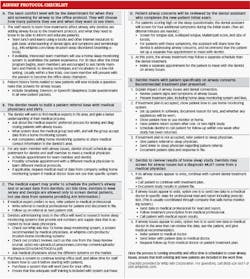Keep your team breathing: Screening for airway issues
I recently met a dentist at a mini-residency program about dental sleep medicine. His practice was less than an hour’s drive from my office, so we decided to stay in touch as we continued to study and understand what interested both of us: the connections between airway, the value of sleep, keeping teeth in occlusion, and what’s in the rest of the mouth.
From the occlusion viewpoint, we know there are times that restorations fail even though we have followed all of the guidelines for joint position and occlusal harmony. Patients continue to brux, suffer from GERD, and have uncontrollable tongues that wreak havoc on their teeth. A simple home sleep test can now be used by dentists in most states to evaluate a patient’s airway as part of the treatment plan. In doing so, dentists are able to identify patients with sleep disordered breathing, refer them to a , and sync the medical and dental plan for patient care.
The concept made sense; however, the dentist and I both knew the top two reasons for failure when implementing airway focus into the dental practice—getting the staff to buy into the concept and mastering medical insurance billing. To address the first one, we used the following guidelines when we met with the dentist’s team.
Start at the beginning and share the basics—After six days of intense training on airway issues during sleep, it was easy for us to see how dentists could incorporate airway into the current practice protocol. However, everything relating to airway was new to the staff, and to them it seemed like the dentist was starting a totally different business venture. Their practice was already very busy, and they wondered where they would find time for the new patients. We were starting with current patients in the practice, so the goal was to develop a protocol to address both dental and airway concerns.
Be ready for questions—The already-busy atmosphere in the dental practice was very apparent as soon as I walked in. Questions such as, “How are we going to handle all these new patients?” and “Are we going to have to increase our office exam time?” were asked before I could inquire about how much the team already knew about sleep apnea dentistry.
Figure 1: Nox T3
Work together on the plan—To answer the staff’s many operational questions, we walked through the entire process for how add airway screening could be added into their current structure. We created a checklist for them to follow:
• Use a questionnaire to identify patients with potential sleep disordered breathing.
• Review four signs and symptoms during the exam that could be completed in two minutes.
• Test with a home sleep monitoring system, such as the Nox T3 (figure 1), unit for objective data.
• Create a referral process for partnering with the medical team.
• Understand how to charge for the new services. Download a copy of this checklist from whipmix.com/wp-content/uploads/Airway-Protocol-Check-List.pdf.
Choose how many patients you want to start screening—While most dental offices screen patients for airway claim to see at least one person a day who should have a follow-up airway study, the team can implement this additional service at their own pace.
Be prepared for conflicts—We thought it would be a great learning experience to have one or two staff members use the Nox T3 home sleep monitoring system. When the results revealed that one of the staff members had moderate sleep apnea, it turned into our first encounter with patient denial. This was good practice for additional education and medical collaboration.
Appreciate team efforts—The respect between the dentist and his team members has been very apparent throughout this new learning process. It is important that the dentist continues to show that he values the team’s efforts as they step out of their comfort zone to implement airway screening in the dental practice.
This dentist is committed to adding a focus on airway into his practice, and acknowledges the work that needs to be done to help his team accept and embrace change.
For those of you considering this, I wish you well on your journey. May your dental procedures be predictable, your office traffic considerable, and your airway screening processes indispensable.
Lorena Lighthart is the product manager for the Clinical Products Division at Whip Mix. She has worked in the dental industry for more than 30 years. Lorena works with a myriad of experts in the field to bring new products to market that support functional occlusion, esthetics, and healthy sleep.


